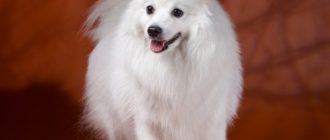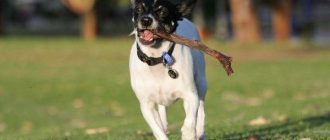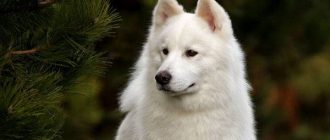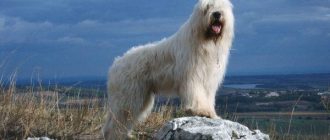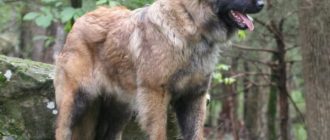Assessment of breed characteristics
Contents
| Adaptability Definition of how easy a dog is. can adapt to changes in life. |  |
| Shedding Level Level and frequency of hair loss in animal. |  |
| Level of tenderness Level and amount of tenderness and affection that the dog gives back in return for attention to itself. |  |
| Need for Exercise Daily Activity Level dogs. |  |
| Social need Required number of dog contacts with other animals as well as people. |  |
| Housing ratio Factor that determines the level of noise and other inconvenience that the dog can deliver to the owners in the ratio the size of the apartment to the size of the dog. |  |
| Grooming Number of bathing, combing, as well as necessary number of professional grooming sessions required the dog. |  |
| Friendliness in an unfamiliar environment society with strangers or in an unfamiliar environment. |  |
| The tendency to bark The tendency to bark and its frequency and volume. |  |
| Health Issues Potential Health Status dogs. |  |
| Territorial tendency of the dog to protect his house, yard or even a car owner. |  |
| Cat friendliness A trend towards cat tolerance and reduced manifestation of hunting instincts. |  |
| Intelligence Dog’s ability to think and solve emerging difficulties (not to be confused with learning!). |  |
| Education and training Level of difficulty in training a dog perform certain actions. |  |
| Friendliness for children Factor determining how much the dog friendly to children, whether she likes to play with them and endure some children’s pranks. |  |
| Game activity The concept is determined by its very name, and, usually found in almost all dogs. |  |
| Observability Dog’s ability to detect presence a stranger in his territory. |  |
| Friendliness for other dogs Dog’s tendency to find common language with other relatives. |  |
Brief description of the breed
Shetland Sheepdog was a working assistant to farmers on Shetland Islands off the coast of Scotland. They were not only unsurpassed watchmen, but proved to be excellent in quality shepherd dogs. Today the Shetland Sheepdog, which is often called Sheltie has become an excellent companion dog and a true member family. Sheltie looks like a miniature collie. She has a beautiful thick wool and a very flexible body. The sheltie head is somewhat elongated and narrowed. She has dark almond-shaped eyes and a black nose. Blue eyes of this breed are extremely rare. Small ears sheltie always upright. The body of dogs of this breed is muscular, but not heavy. A distinctive feature of sheltie is the presence of a certain lion’s mane dark color. The main color is black with white spots and tan color. Shelters who have been faithful friends for a long time. Scottish farmers tend to sound the alarm dangers, although often they can bark even at birds flying in master’s garden. All this is the result of the shepherd’s past of the animal, who faithfully served in the pastures. Despite the fact that Shetland the shepherd looks like a reduced collie, yet these are two completely different breeds. These dogs make excellent watchmen. But just this can only be achieved through proper education and Sheltie is a true companion for all family members in including for children. However, they may be shy when strangers. The special character of this dog is shaped like this way that sheltie will raise barking at the slightest suspicion of the occurrence of danger. If you want to get rid of this traits, you will have to make an effort in education Any Sheltie owner will confidently say that this dog The breeds are very smart. According to Dr. Stanley, an expert on the intellectual development of animals, sheltie is one of the smartest dogs. According to the results of his research, which he conducted on dogs of 132 different breeds, Sheltie took sixth place. She is capable understand the new team that he hears for the first time. Because of good intelligence, insane desire to please his master and excellent athletic abilities, these dogs occupy a leading position in popularity among dogs of appropriate sizes. Particular success Sheltie achieve in competitions related to the implementation of various teams. They also show unrivaled abilities in tasks, related to agility and search. Based on what sheltie has the reputation of a very smart dog, it needs a lot of intellectual exercises. In case of absence mental stimulation the pet will become bored. And that means that the dog will begin to independently seek for entertainment that may not like the owner. Sheltie preserved pronounced shepherd’s instinct. Anyone will notice that the dog will not miss the opportunity chasing after small animals, and when he catches up with them, there will be them bite, that is, do what they usually do during grazing sheep. This habit must be controlled. The fact, that such behavior can occur in relation to children, and this can lead to undesirable consequences. That’s why it is necessary to suppress the dog’s attempts to chase after animals. Being indoors, sheltie do not show much activity. Therefore, you can keep a dog of this breed in apartment. True, in this case, the pet must be loaded active exercises. When staying in the private sector is better just protect the yard with a reliable fence so that your pet doesn’t rushed in pursuit of small animals or a car. Sheltie – This is a dog with long, dense hair, prone to active molting. Many people who purchase a dog of this breed do not even imagine how much wool will appear in their home with insufficient care dog. Sheltie can be a good choice for working people. Dogs of this breed can quite easily tolerate time. loneliness while the owner at work, but for this it is necessary to pay the dog has a lot of attention in his spare time. The animal must not feel abandoned and unnecessary. Shelters are best developed in families, where they pay a lot of attention, where they play, caress and etc. Such an attitude to the pet will return to the family with the toric.
Sheltie photo:





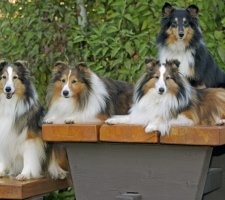
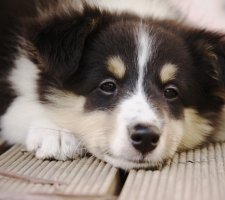
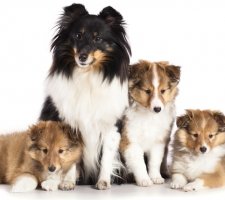
 Photo of Sheltie dogs |
Photo of Sheltie dogs |
Origin history
A miniature collie breed of dog has been bred on Shetland Islands, which lie about 50 kilometers from Scottish coast. Many animals appeared on these islands. dwarf breeds, including Shetland ponies, Shetland sheep. This area is a rocky region with scarce vegetation. Given that the dog throughout history developed in a limited area, understandable become the size of a dog. In the eighteenth century the Shetland Islands often visited fishing boats. Many fell on them on the island. dog breeds, including spaniels, spitz, various shepherd dogs. Crossbreeding different breeds of dogs led to the emergence of a new breed, which we now know as sheltie. Interest in this animal as a the companion dog began to appear only in the nineteenth century, when the islands were visited by English sailors. They started to buy dogs of this breed to keep them at home. First sheltie officially was shown in 1906, then it was positioned as a miniature collie. In 1908, a club was organized in the Shetland Islands sheltie. It was discovered in the capital of the islands – the city of Lerwick. Breed was recognized by the British Kennel Club in 1909 as shetland collie. But already in 1914 managed to achieve recognition separate breed – sheltie. In many ways, it was the merit of the owners. collies who didn’t really want collies to be compared with Sheltie. The American Kennel Club has registered Sheltie as a separate breed in 1911. In 1929, a club was established. Sheltie fans. In the same year, an exhibition was held in London, at which sheltie was presented as a separate breed. After sheltie New Yorkers saw at the Dog Club show. It happened in 1933 year. This was followed by a series of long discussions about the creation of breed standard and the development of correct descriptions of all the nuances of this breed. According to the American standard, sheltie growth should be in within 33-41 centimeters.
Sheltie character
Sheltie is extremely loyal, gentle and sensual. to dogs. The nature of these dogs can be different: from shy to very active and noisy. Anyway, all representatives of this breeds do not represent their life outside the family. They want to be in spotlight and take part in all family events, both at home and outdoors. They get along well with children and love to frolic with them. Quite often, shelties become winners in various competitions, including agility. These dogs are suitable for active families.
Maintenance and care
Sheltie wool requires combing at least once a week. This must be done with a special massage brush. Such a care will allow timely removal of all dead hair, prevent the formation of pellets and the spread of wool around the house. During combing it is very important to start combing hair starting from their very foundation. In this case, before combing on the wool you need apply a special moisturizing spray. As a rule, males are actively molt once a year, but females – two. Sheltie wool has waterproof properties. Thanks to what is not repelled only moisture, but also dirt. That is why dogs of this breed bathe only as needed. Ears must be checked weekly. Sheltie for signs of infection, inflammation and irritation. They treat the ears with a special solution, which should be prescribed veterinarian. Weekly mandatory procedures include teeth cleaning. This will prevent tartar and will prevent the appearance of gum disease. If the dog herself is not grinds the claws, then they need to be trimmed. Usually this procedure spend once a month.
Training and training
Sheltie is very easy to train and train. All new teams they just grab on the fly, because they really want to please their to the owner. For the sake of praise, they will do everything. Therefore, during training motivation is necessary, it can become not only goodies, but also praise. Shelty can be called showmen. Fact that they adore be the center of attention. They like to show to the public. various tricks.
Health and Disease
Sheltie’s average lifespan is 12-14 years. TO The main health problems of Sheltie include: eye anomaly, dermatomyositis, hemophilia, hip dysplasia, hypothyroidism, hemorrhagic gastroenteritis, von Willebrand disease, Legg-Calve-Perthes disease, weakening of the wrist ligaments polyarthritis, neoplasms of the nasal cavity, congenital deafness, inversion of the eyelids, corneal dystrophy, cataract, cryptorchidism, testicular neoplasia, gene mutations, open arterial duct, progressive retinal atrophy. This breed is especially sensitive to drugs like ivermectin and milbemycin.

